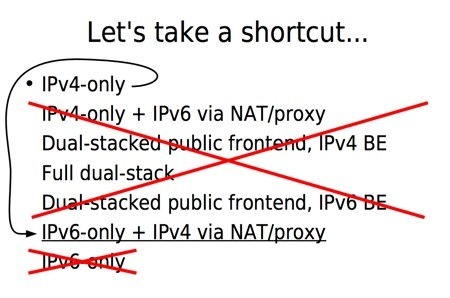Why don’t we just skip dual-stack and other transition technologies and jump straight to IPv6-only data centers that use a gateway/proxy server to service IPv4 requests? That’s the fundamental question Tore Anderson posed in his presentation to the V6 World Congress last week in Paris: “The Case For IPv6-Only Data Centers” (PDF). Here’s what was for me the key slide:
Tore goes on to explain how this can be done using Stateless IP/ICMP Translation (SIIT), also known as “Stateless NAT64″ and “IVI” and defined in RFC 6052 and RFC 6145. Through a series of examples and diagrams he shows how IPv4 traffic would pass through the SIIT gateways into the IPv6 data center and then back out again. He explains the advantages of this setup and concludes with a configuration example and remarks that he’s using this exact setup for his own website and that of his employer.
It’s certainly an intriguing approach and I’m now thinking I may work on setting this up in my IPv6 lab I’m working on.
What do you think? Do you like the idea of just migrating once to an IPv6-only data center?


 In a post out yesterday, “
In a post out yesterday, “
